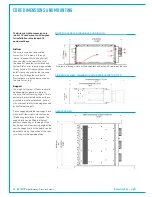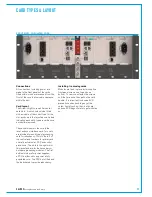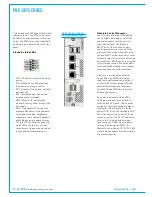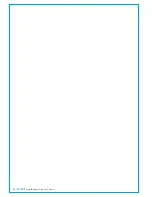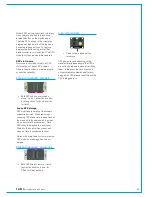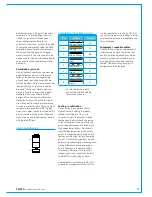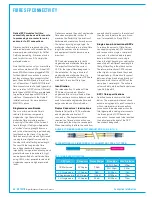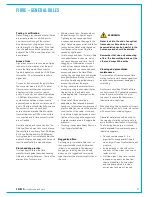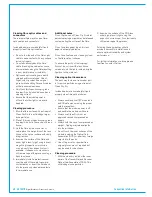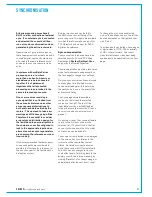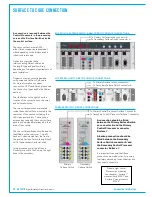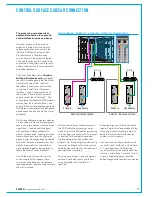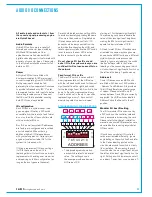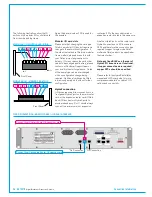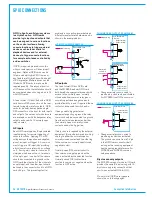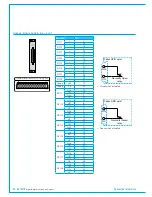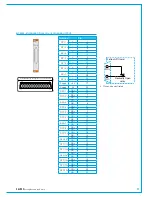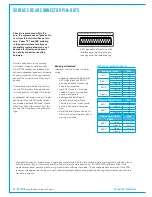
CALREC
Putting Sound in the Picture
47
Testing/certification
Calrec strongly recommends that all fibres
are properly tested or certified prior to
on-site commissioning of the system.
A certain amount of signal loss occurs
over the length of a fibre path. If the total
loss of a path exceeds the optical power
budget of the SFPs in use, the system will
be unreliable.
Areasofloss
Signal loss occurs in various areas. Splice
loss occurs in terminations - at the point
where the fibre meets the connector.
Typically splice loss should be <0.3dB per
termination. Poor termination results in
higher loss.
Connector loss occurs at the point where
the connector meets the SFP / optical
transceiver, or another connector, such
as extension interconnects or patch-
points. Connector loss should typically be
<0.5dB per interconnect. Dust or other
contamination between interconnects
and scratches on the end surface contact
point of the fibre will substantially increase
the amount of loss. As such, dust
covers should always be fitted to optical
transceivers such as SFPs when no fibre
is connected and to fibre connectors that
are not landed.
As well as splice and connector loss, the
fibre itself has inherent loss over distance,
typically fibre loss will vary from 3.5dB per
km for multimode down to 0.4dB per km
for singlemode. Poor installation practise
and lack of care can damage the fibre and
result in substantially increased losses.
Fibrehandlingpractise
It is important to follow the fibre
manufacturer's guidelines when handling
fibre and installing fibre runs. Some of the
main points of concern are:
• Minimum bend radii - fibre should not
be bent through too tight an angle.
Tight angles can cause significant
losses and permanent damage to the
fibre. Fibres may pass initial installation
testing but can fail at a later date due
to stresses on the core of the fibre
caused by tight bends.
• Twists, snags and kinks - Twists in fibre
runs add stresses to the core which
can cause damage over time. Avoid
snagging on other cables or conduit
which will cause excessive tensions
when pulling and can cause kinks and
excessive bends in the fibre. When
routing through angled conduit, provide
enough clearance around corners to
avoid the fibres being pulled sharply
around the inside of the angle.
• Pulling - observe the manufacturers
maximum pulling tension specification.
Use pulling tools and lubrication
where appropriate. Never pull on the
connector.
• Strain relief - fibres should be
adequately strain relieved to prevent
tension on terminations, however use of
plastic cable ties can crush the internal
construction of the cable. Hook-and-
loop 'Velcro' straps are harder to over-
tighten, offer more gentle support and
a greater surface area to dissipate the
pressure.
• Crushing - never place heavy items on
top of unprotected fibre.
Ruggedisedfibre
For temporary / re-usable fibre runs , or
runs unprotected by conduit, fibre that
is likely to be exposed to the elements,
snagging or to being stood on, should
always be of a ruggedised / armoured
type to protect the internal construction of
the core.
WARNING
Never look into the end of an optical
transceiver or fibre when in use.
Laser radiation can be harmful to the
human eye and should be avoided.
Remember that when disconnecting
a fibre, the transmitting device at the
other end may still be active.
FIBRE - GENERAL RULES
Cleaningandpreventative
maintenance
Contamination of transceiver and fibre
mating contact points causes signal loss
and can cause permanent damage by
scratching.
Dust covers should be fitted to all fibre
connectors and SFP optical transceivers
when they are not mated. It is also
important to ensure that dust covers
themselves are kept clean.
When handling fibres without dust covers,
do not allow the ends to come into contact
with any surface, including fingers.
Specialist materials should be used for
the cleaning of mating contact points to
avoid further contamination or scratching.
The following items are low cost and
readily available from camera shops and
laboratory suppliers:
• Canned compressed air - it is
important to use specialist filtered,
clean, dry air, free of contaminants and
moisture.
• Isopropyl alcohol. Use with cotton
swabs or lint-free wipes to ensure no
residue is left.
• Lint free wipes / long fibre, low ash
lens paper - needs to be free from
chemical additives. Ensure wipes
and swabs are stored in a clean
environment and are not reused.
Summary of Contents for Artemis
Page 5: ...calrec com Putting Sound in the Picture ARTEMIS INFORMATION...
Page 9: ...calrec com Putting Sound in the Picture ARTEMIS CONTROL SURFACE...
Page 26: ...26 ARTEMIS Digital Broadcast Production Console...
Page 27: ...calrec com Putting Sound in the Picture ARTEMIS PROCESSING CORE BEAM SHINE...
Page 33: ...calrec com Putting Sound in the Picture ARTEMIS PROCESSING CORE LIGHT...
Page 40: ...40 ARTEMIS Digital Broadcast Production Console...
Page 41: ...calrec com Putting Sound in the Picture ARTEMIS CONNECTION INFORMATION...
Page 66: ...66 ARTEMIS Digital Broadcast Production Console...
Page 67: ...calrec com Putting Sound in the Picture ARTEMIS EXTERNAL CONTROL...
Page 80: ...80 ARTEMIS Digital Broadcast Production Console...
Page 81: ...calrec com Putting Sound in the Picture ARTEMIS SETUP CONFIGURATION...
Page 100: ...100 ARTEMIS Digital Broadcast Production Console...
Page 101: ...calrec com Putting Sound in the Picture ARTEMIS PANEL OPTIONS...
Page 110: ...110 ARTEMIS Digital Broadcast Production Console...
Page 111: ...calrec com Putting Sound in the Picture ARTEMIS OBSOLETE PANELS...
Page 114: ...114 ARTEMIS Digital Broadcast Production Console...
Page 115: ...calrec com Putting Sound in the Picture ARTEMIS SPECIFICATIONS...


